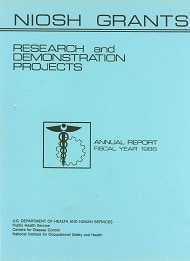NIOSH Research and Demonstration Grants. Fiscal Year 1986
June 1987
DHHS (NIOSH) Publication Number 87-109

This report was intended to serve as a readily available source of information on the status and scope of the fiscal year 1986 research grants programs of NIOSH, as a means of stimulating the development of high quality proposals for research on significant occupational safety and health issues. The programs were divided into specific areas of research as follows: occupational lung diseases (aerosol deposition, granite workers, fiber deposition, pneumoconiosis, sandblasting, poultry workers, semiconductor workers, cancer risk, tannin, phosgene (75445), silicosis, mineral dusts, beryllium (7440417) workers, farmer’s lung, and cotton dust); musculoskeletal injuries (etiology, low back injury, muscle function, fatigue, lifting capacity, hand tools, posture); occupational cancers (carcinogens, mutagens, formaldehyde (50000), hepatotoxicity, dry cleaning industry, nucleosides, diesel emissions, leukemia risk in linemen, prostaglandin synthetase, DNA, antineoplastic agents); traumatic injuries including grain elevator workers and explosions; cardiovascular disorders including the Framingham study and lead (7439921) exposures; reproductive disorders (pesticides, dinitrotoluene (25321146), toluenediamine (25376458), solvent exposures, testicular injury, DNA, gap junctions, biliary atresia, germ cell mutation, acrylamide (79061)); neurotoxic disorders (neuropathology, diketones, acrylamide, neurobehavioral tests, Alzheimer’s disease, animal studies); noise induced hearing loss (impulse noise, cochlear injury, industrial noise, high blood pressure, temporary threshold shift, hearing protection); dermatologic conditions (agricultural chemicals, dosimeters, phenols); psychological disorders (stress, sex factors, neuropsychological effects, solvent exposures, and behavior modification); control systems; and respirator research.
NIOSH Research and Demonstration Grants. Fiscal Year 1986 pdf icon[PDF – 26 MB]
